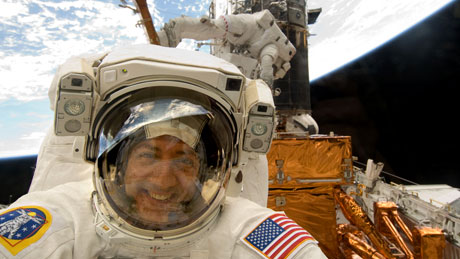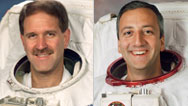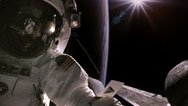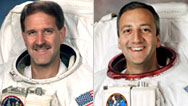
Saving Hubble Update
Two teams of spacewalkers take on unprecedented challenges to repair the world's most beloved telescope. Airing August 25, 2009 at 9 pm on PBS Aired August 25, 2009 on PBS

Program Description
Transcript
Saving Hubble Update
PBS Airdate: August 25, 2009
NEIL DeGRASSE TYSON: Hi, I'm Neil deGrasse Tyson, your host of NOVA scienceNOW.
Here's a question I get asked a lot: "How many astrophysicists does it take to change a light bulb?" Well, depends on the circumstances. For instance, what if the light bulb is on a priceless crystal chandelier and you had to change the light bulb wearing boxing gloves? And what if that chandelier is way up high and you have to stand on the top of a tall, rickety ladder to reach it?
Whoa!
What if this intricate job must be performed in space?
These are just the sorts of challenges, all together, at once, facing astronauts on an important and risky mission. A team of specialists prepares for emergency surgery, a risky procedure that will cost millions.
Luckily, this patient is a celebrity, with an excellent health plan—courtesy of the U.S. government—the Hubble Space Telescope.
The Hubble is probably the best-known scientific instrument ever. Since 1990, it's brought us unprecedented views of the universe and revolutionized astrophysics.
MATT MOUNTAIN: Twenty years ago, before the Hubble flew, we didn't know how big the universe was or how old it was. Now we do. We didn't know that black holes really existed. We now know that black holes are everywhere. And the Hubble telescope was the first telescope to actually examine the composition of a world around another star. Without the Hubble, none of those things would have happened.
NEIL DeGRASSE TYSON: But by last year, Hubble was in trouble. It was dying, and half its instruments, including the camera that took these pictures, were already dead. The only hope to save Hubble was a shuttle mission, launched this past May.
Launch day, Kennedy Space Center: Within an hour from now, space shuttle Atlantis will launch, carrying a crew of astronauts to repair and service the Hubble telescope for the last time.
I'm not the only one here to witness this historic launch. There's a few thousand spectators, plus news media. This will be the most closely watched shuttle mission in years, because of Hubble's unprecedented popularity.
Images from the Hubble telescope brought the universe into our collective backyard. There's nothing else like it in the history of science. So it's a bit emotional for me. I have friends and colleagues on the space shuttle Atlantis. So, good luck, Atlantis. Godspeed.
NASA SPACE SHUTTLE MISSION CONTROL: 8, 7, 6...2, 1...liftoff of space shuttle Atlantis.
NEIL DeGRASSE TYSON: The climb to orbit takes just over eight minutes.
ASTRONAUT 1: Vehicle rolling to heads up now to get good communication.
NEIL DeGRASSE TYSON: Once there, it will take them two days to catch up to Hubble. Then the real work can begin.
MICHAEL MASSIMINO (NASA Astronaut): We're in the middeck of space shuttle Atlantis, with my buddy John Grunsfeld over here.
JOHN GRUNSFELD: And our spacesuits are here. We're getting ready to go outside.
MICHAEL MASSIMINO: So it's a busy day, and things are just going to keep getting busier.
NEIL DeGRASSE TYSON: It starts with grabbing hold of the telescope.
ASTRONAUT 1: Megan McArthur now repositioning the shuttle's robotic arm to align with the telescope.
NASA SPACE SHUTTLE MISSION CONTROL: Houston, Atlantis. Hubble has arrived onboard Atlantis.
MICHAEL MASSIMINO: If you look out there, there's a telescope waiting for us to start working on it.
NEIL DeGRASSE TYSON: The work will start tomorrow: five spacewalks, one per day. But the preparation began long ago; these five days have been years in the making.
It all starts in 2006, when two teams of astronaut spacewalkers are assigned to the job. John Grunsfeld leads one team; he's been to Hubble twice before.
JOHN GRUNSFELD: The Hubble was designed to be serviced by people, to take things out, put things in, turn bolts, keep it running.
NEIL DeGRASSE TYSON: John's partner is Drew Feustel. This will be his first flight.
DREW FEUSTEL: We kind of operate on a buddy system. One person does the work, another person's handing off tools, providing support.
NEIL DeGRASSE TYSON: On the second team is Mike Good, also making his first flight.
MICHAEL GOOD (NASA Astronaut): Hubble's done some great things, and it's great to know that I'm going to get to go up and have a chance to get up there and touch it, open the doors, get inside of it to work on it.
NEIL DeGRASSE TYSON: Leading the second team is veteran spacewalker Mike Massimino. He worked with John Grunsfeld on Hubble, in 2002.
MICHAEL MASSIMINO (NASA Astronaut): If we can fix Hubble, with its new capabilities, it's going to make some great discoveries.
NEIL DeGRASSE TYSON: There's lots to do: replace batteries, install a brand new camera, swap out gyros, remove old optics, install a new spectrograph, and more.
MIKE MASSIMINO: Generally, what we do is we come up with a whole replacement for an instrument or for a piece of equipment. And even if something little is wrong with it, you don't mess with it, usually. You just pull it out and put the whole new one in.
NEIL DeGRASSE TYSON: That's exactly what Drew Feustel and John Grunsfeld are about to do on spacewalk number one:...
DREW FEUSTEL: Ready, John. Let's do this.
Oh, this is fantastic.
NEIL DeGRASSE TYSON: ...pull out the old wide field camera, and put in a new one.
They'll loosen one bolt, remove the old camera...
DREW FEUSTEL: Copy, John.
NEIL DeGRASSE TYSON: ...insert the new camera, and re-tighten the bolt; one of the simplest jobs on the entire mission.
But early on, there's a big problem.
DREW FEUSTEL: Mass, I put in three attempts, and see no motion on the A-latch bolt.
MICHAEL MASSIMINO: Copy.
NEIL DeGRASSE TYSON: When Drew Feustel tries to loosen the bolt holding in the old camera, it refuses to budge.
DREW FEUSTEL: No turning.
MICHAEL MASSIMINO: Try it without a M.T.L. at all.
NASA SPACE SHUTTLE MISSION CONTROL: NASA copy that. In that case, we're with removing the M.T.L.
NEIL DeGRASSE TYSON: The M.T.L. is a multi-torque limiter, a safety feature. It limits the force on the bolt to keep it from breaking.
With no M.T.L., there's a chance Drew could break the bolt, putting Hubble in danger.
DREW FEUSTEL: How far can we go with this, and what are the implications if I break the bolt?
JOHN GRUNSFELD: If it breaks, then wide field stays in.
NASA SPACE SHUTTLE MISSION CONTROL: What John said is correct.
DREW FEUSTEL: Thanks.
NEIL DeGRASSE TYSON: If the bolt breaks, the old wide field camera is stuck in Hubble forever. The replacement, a brand-new $130-million-dollar camera, which took more than 10 years to build, will come back to Earth, never to be used.
DREW FEUSTEL: Okay, here we go. I think I got it. It turned; it definitely turned.
NASA SPACE SHUTTLE MISSION CONTROL: We copied and saw that. That's great news.
JOHN GRUNSFELD: Well, it's been in there for 16 years, Drew.
DREW FEUSTEL: It didn't want to come out.
JOHN GRUNSFELD: I guess it just decided to be a recalcitrant teenager.
NASA SPACE SHUTTLE MISSION CONTROL: And the Wide Field Planetary Camera 2 is clear of the structure of the telescope.
MICHAEL MASSIMINO: That's awesome news, Dan.
NEIL DeGRASSE TYSON: In the end, John and Drew finish everything spacewalk number one was supposed to get done. But it was a close call that could have permanently crippled the telescope.
The next day, spacewalkers Mike Massimino and Mike Good also have problems.
NASA SPACE SHUTTLE MISSION CONTROL: Crew members are an hour and a half behind the timeline at this point.
NEIL DeGRASSE TYSON: The second spacewalk ends up taking just under eight hours, one of the longest in NASA history.
The first two days have not gone well. And the hardest spacewalks are yet to come. Tomorrow, John and Drew will try to fix a broken instrument that can't be replaced: the Advanced Camera for Surveys, or ACS, which died in 2007.
It's a new kind of work no one's ever done before: actual repairs in space.
CHUCK SHAW (Director, Hubble Servicing Mission): Instead of just replacing or adding components, we're actually going inside. It's more like neurosurgery.
NEIL DeGRASSE TYSON: To learn how they'll try to do these repairs, months before launch I went to Goddard Space Flight Center, in Maryland. Deputy Program Manager Mike Weiss took me through the world's largest cleanroom. Every tool, part and new instrument going to Hubble is kept here.
In the heart of this super clean operating room, is a life-sized mockup of the patient: the part of Hubble containing the instruments. Deep inside is A.C.S., the vital organ that's failed. It might look like a refrigerator, but this big black box is actually a precision digital camera.
Just like any digital camera, A.C.S. runs off electronics. And that's what's died, the power supply. To fix it, 32 tiny screws have to be removed, then a cover, then circuit boards have to come out.
Okay, so this would be the offending power supply board?
MIKE WEISS: Right.
NEIL DeGRASSE TYSON: Even though right now it's just a smooth surface, I would see printed circuitry here and...
MIKE WEISS: Absolutely.
NEIL DeGRASSE TYSON: ...components?
MIKE WEISS: And they're going to pull all four of these boards out.
NEIL DeGRASSE TYSON: So this seems easy enough. Where's the challenge?
MIKE WEISS: The challenge is it was never designed to be pulled out like that, with an astronaut wearing a glove, and it could compromise the glove. It could have sharp edges.
NEIL DeGRASSE TYSON: "Compromise the glove" is euphemism for me losing the pressurization of my suit and dying?
MIKE WEISS: Ultimately.
NEIL DeGRASSE TYSON: Danger is just one challenge. Working while weightless is quite another. Things like tools and loose screws will float. And if you're not strapped down, when you try to turn a screw, your body turns instead.
And, ultimately, if just one of those 32 screws that has to be removed to fix the A.C.S. should float into Hubble, it could trash the telescope forever.
So how are they going to get those screws out safely? With a special contraption designed just for this mission: the Fastener Capture Plate.
JOHN GRUNSFELD: It's basically a panel that is made out of a clear plastic and has holes in that you can put a screwdriver through.
MIKE MASSIMINO: But small enough so that nothing will come out.
JOHN GRUNSFELD: As a result, we can remove all those screws. They'll float around, but we won't lose any. And then we can take the cover plate off.
NEIL DeGRASSE TYSON: To get a feel for what it's like using the Fastener Capture Plate, I decided to try it myself.
MIKE WEISS: You then need to turn three levers.
NEIL DeGRASSE TYSON: Three different screws.
MIKE WEISS: One, two, and three different locations.
NEIL DeGRASSE TYSON: There we go.
In space, 32 screws have to come out. I figured I'd try two. So I've got my miner's light into number 17. Steady. There we go. I'm in. We are succeeding, I think. I am not succeeding. And I can't imagine doing this in a spacesuit.
But doing it in a spacesuit is precisely what John Grunsfeld is facing on spacewalk number three.
JOHN GRUNSFELD: The Fastener Capture Plate will be next.
NASA SPACE SHUTTLE MISSION CONTROL: The Fastener Capture Plate now removed, having done its job...
NEIL DeGRASSE TYSON: But as the repair gets underway...
NASA SPACE SHUTTLE MISSION CONTROL: ...capturing the 32 tiny screws.
NEIL DeGRASSE TYSON: ...the one thing that nobody expects is what actually happens: perfection.
JOHN GRUNSFELD: Card one is out.
NASA SPACE SHUTTLE MISSION CONTROL: Nice.
JOHN GRUNSFELD: I heard that.
NEIL DeGRASSE TYSON: No loose screws; no cut gloves.
NASA SPACE SHUTTLE MISSION CONTROL: Oh, that's unbelievable!
NEIL DeGRASSE TYSON: The A.C.S. repair, probably the toughest job on the whole mission, goes without a single hitch.
Down on the ground, the Goddard engineers who designed the tools and planned the repair are thrilled.
NASA ENGINEER 1: It was a good one today.
MARK JAROSZ (NASA Engineer): No issues, ahead of the timeline, it went smooth, just like they practiced it.
NEIL DeGRASSE TYSON: Over the next two days, the final spacewalks complete every task assigned to the mission.
NASA SPACE SHUTTLE MISSION CONTROL: The final spacewalk to service the Hubble Space Telescope is complete.
NEIL DeGRASSE TYSON: This mission hasn't just fixed Hubble, it's set a new precedent for the level of intricate repair work that's possible on spacewalks.
MATT MOUNTAIN: We've pulled out boards, replaced boards, struggled with, you know, handles that wouldn't come off, and improvised. I mean, I think we have raised the bar enormously, because suddenly you can see what humans can do in space.
NEIL DeGRASSE TYSON: The day after the final spacewalk, Hubble is released back into its own orbit. It's the last time humans will ever touch or see this magnificent science instrument.
MICHAEL MASSIMINO: What were you thinking when you patted Hubble goodbye?
JOHN GRUNSFELD: "Happy voyages. I hope everything that we did worked."
NEIL DeGRASSE TYSON: Over the next few months, the new instruments get acclimated to the conditions of space. And I can't wait to see what a rejuvenated Hubble can do.
MATT MOUNTAIN: It's probably between 50 and 100 times more powerful than it was when we first launched the Hubble, so it's a completely new telescope.
NEIL DeGRASSE TYSON: Just weeks ago, Hubble transmitted the first post-repair images. It's the start of a new era in Hubble history, and later this fall, you can see those images and watch the story of the whole mission on NOVA.
On Screen Text: The Hubble Space Telescope is the same length as a school bus. They also weigh about the same. A school bus costs about $1,499,890,000 less, but the Hubble is way cooler than a school bus.
Broadcast Credits
Saving Hubble Update
- Edited by
- Doug Quade
- Written, Produced and Directed by
- Rushmore Denooyer
NOVA scienceNOW
- Executive Producer
- Samuel Fine
- Executive Editor
- Neil deGrasse Tyson
- Senior Series Producer
- Vincent Liota
- Senior Producer
- Julia Cort
- Supervising Producers
- Stephen Sweigart
Joey David Jovanovich - Senior Editor and Colorist
- David Chmura
- Online Editor
- Laura Raimondo
- Senior Researcher
- Sharon Kay
- Associate Producer
- Fran Laks
- Assistant Editors
- Rob Chapman
Tung-Jen (Sunny) Chiang - Graphic Design
- Brian Edgerton
- Compositor & Animator
- Yunsik Noh
- Music
- Rob Morsberger
- Sound Mix
- Bill Cavanaugh, RazorMix, Inc.
- Assistant to Neil deGrasse Tyson
- Elizabeth Stachow
- NOVA scienceNOW Series Animation
- Edgeworx
- Correspondent for Memory segment
- Chad Cohen
- Correspondent for Memory segment
- Chad Cohen
- Correspondent for Gangster Birds segment
- Doug Quade
- Researcher, Creative Consultant for Memory Segment
- Ethan Herberman
- Associate Producers
- Julie Crawford
Melanie Cunningham - Camera
- Chad Baron
Christine Burrill
Thomas Danielczik
Marten Kaufman
Edward Marritz
Michael D. McClare - Sound Recordists
- Chad Baron
Giovanni DiSimone
Bryan Kweskin
Mark Mandler
Jerry Rose - Animation
- Sputnik Animation
James LaPlante
Doug Quade
Noisy Neighbor Productions
David Grubin Productions
Philip Pfeifer, Insight Animations - Stills Animation
- Dan Nutu
- For Lone Wolf Documentary Group
-
- Executive Producer
- Kirk Wolfinger
- Production Manager
- Donna Huttemann
- Archival Material
- Antler Ridge Wildlife Sanctuary
BBC Motion Gallery
John Benson
Miquel Bosch
Corbis Images
Suzanne Corkin
Eric Kandel
The Macaulay Library at the Cornell Lab of Ornithology
Brenda Milner
NASA
Brian Salzberg - Special Thanks
- Jeffrey Burcher
Courtney Emmett
Bruce Fischl
Itzhak Fried, UCLA
David Glanzman, UCLA
Goddard Space Flight Center
Johnson Space Center
Kennedy Space Center
Athinoula A. Martinos Center for Biomedical Imaging
Montreal Neurological Institute
National Aeronautics and Space Administration Headquarters, Washington D.C.
Susan D. Phipps
Space Telescope Science Institute
Larry Squire, UCSD
Allison Stevens
The Crew of STS-125
Andre van der Kouwe
Benjamin Whatley - Neil deGrasse Tyson
- is director of the Hayden Planetarium in the Rose Center for Earth and Space at the American Museum of Natural History.
- NOVA Series Graphics
- yU + co.
- NOVA Theme Music
- Walter Werzowa
John Luker
Musikvergnuegen, Inc. - Additional NOVA Theme Music
- Ray Loring
Rob Morsberger - Post Production Online Editor
- Spencer Gentry
- Closed Captioning
- The Caption Center
- NOVA Administrator
- Mykim Dang
- Publicity
- Carole McFall
Eileen Campion
Victoria Louie
Karinna Sjo-Gaber
Karen Laverty - Marketing
- Steve Sears
- Researcher
- Kate Becker
- Senior Researcher
- Gaia Remerowski
- Production Coordinator
- Linda Callahan
- Paralegal
- Sarah Erlandson
- Talent Relations
- Scott Kardel, Esq.
Janice Flood - Legal Counsel
- Susan Rosen
- Production Assistant
- Ryan Murdock
- Post Production Assistant
- Darcy Forlenza
- Associate Producer, Post Production
- Patrick Carey
- Post Production Supervisor
- Regina O'Toole
- Post Production Editors
- Rebecca Nieto
Jason York - Post Production Manager
- Nathan Gunner
- Compliance Manager
- Linzy Emery
- Development Producer
- Pamela Rosenstein
- Business Manager
- Joseph P. Tracy
- Senior Producer and Project Director
- Lisa Mirowitz
- Coordinating Producer
- Laurie Cahalane
- Senior Science Editor
- Evan Hadingham
- Senior Series Producer
- Melanie Wallace
- Managing Director
- Alan Ritsko
- Senior Executive Producer
- Paula S. Apsell
This material is based upon work supported by the National Science Foundation under Grant No. 0638931. Any opinions, findings, and conclusions or recommendations expressed in this material are those of the author(s) and do not necessarily reflect the views of the National Science Foundation.
NOVA scienceNOW is a trademark of the WGBH Educational Foundation
NOVA scienceNOW is produced for WGBH/Boston by NOVA
© 2009 WGBH Educational Foundation
All rights reserved
- Image credit: (repair of the Hubble Space Telescope) © NASA
Participants
- Neil deGrasse Tyson
- Astrophysicist, American Museum of Natural History www.haydenplanetarium.org/tyson/profile/bio
- Andrew Feustel
- NASA Astronaut www.jsc.nasa.gov/Bios/htmlbios/feustel-aj.html
- Michael Good
- NASA Astronaut www.jsc.nasa.gov/Bios/htmlbios/good-mt.html
- Mark Jarosz
- Goddard Engineer www.nasa.gov/audience/foreducators/hubble-mark-jarosz.html
- John Mace Grunsfeld
- NASA Astronaut www.jsc.nasa.gov/Bios/htmlbios/grunsfel.html
- Michael Massimino
- NASA Astronaut www.jsc.nasa.gov/Bios/htmlbios/massimin.html
- Matt Mountain
- AURA
- Chuck Shaw
- Director, Hubble Servicing Mission
Preview
Full Program
Full program available for streaming through
Watch Online
Full program available
Soon









